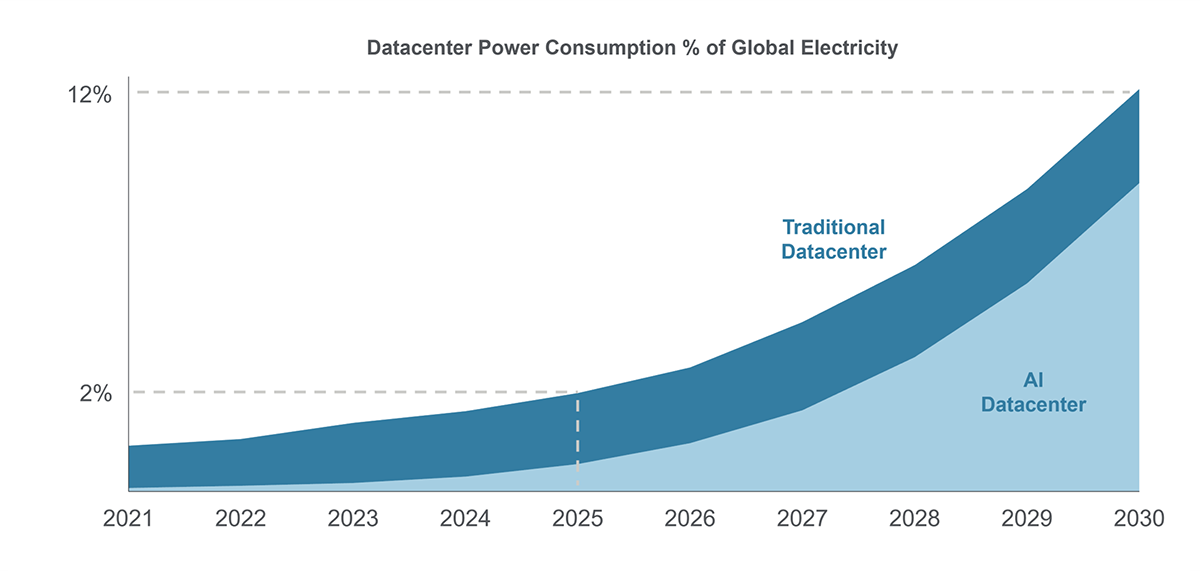Products & Technologies
Products & Technologies
Services
Resources
Posted
June 09, 2025
Delivering Sustainable Energy Abundance for the AI Era

In a new report, Applied Materials teamed up with leaders from across the technology ecosystem to outline a sustainable path for delivering the massive amounts of energy required to support the growth of AI.
Why It Matters: AI has the potential to unlock unprecedented gains in global productivity, but its insatiable demand for power could put increasing strain on electrical grids. Building the computing infrastructure to support AI growth is expected to profoundly reshape the global energy landscape. Today, datacenters account for about 2% of global electricity consumption, or more than the entire country of Germany1. As AI transitions to more complex workloads across both training and inference, compute needs – and thereby power consumption – are expected to increase exponentially. Applied forecasts that datacenter electricity consumption will increase to as much as 12% of the global total by 2030.
1 Source: International Atomic Energy Agency

Datacenter power consumption as percentage of global electricity. Source: Applied Materials
A New Playbook: Simply adding new streams of clean energy production or greatly expanding legacy sources will be insufficient to support the incremental electricity demand of AI. To address the problem, Applied joined forces with chip and energy industry leaders to develop a new playbook to fuel the growth of AI infrastructure. The report, titled Sustainable Energy Abundance for AI, outlines an approach based on three foundational pillars: grid decarbonization, energy-efficient computing, and monetizing new opportunities for semiconductors. While all three pillars are crucial, the report found that restructuring the power grid offers the single biggest opportunity to increase energy availability while reducing carbon emissions.
The Role of Semiconductors: Chips are the foundation of AI computing infrastructure. The semiconductor industry has embraced sustainability initiatives, but the conventional approach has focused primarily on expanding renewable energy sources such as wind and solar or delivering improvements in processing for high-performance computing. These are necessary but not sufficient – they cannot sustainably support the enormous energy requirements demanded by the growth of AI. There is an opportunity for the semiconductor industry to take a leadership role in modernizing the global power grid. For example, innovations in compound semiconductors for power electronics can address data transfer energy consumption within the data center and reduce grid-to-data center power losses.
It Takes an Ecosystem: To prepare the report, Applied collaborated with industry leaders from across the AI technology stack – from chip design and manufacturing to cloud service providers – as well as key thought leaders in the energy and finance sectors. Addressing the energy challenges of AI will require complex industry partnerships and new collaboration models to enable high-velocity co-innovation. As such, the approach outlined in the new report aims to enable the growth of AI while shifting business incentives toward the goal of sustainable energy abundance.
Applied’s View: “This new report presents a holistic strategy that realigns sustainability with energy abundance, ensuring AI’s productivity gains are not sidelined by grid constraints,” said report lead author Sundeep Bajikar, Corporate Vice President, Corporate Strategy and Marketing at Applied Materials. “To truly harness the transformative productivity and prosperity potential of AI, we need a comprehensive sustainability strategy that expands clean energy capacity, modernizes energy infrastructure, and maintains diverse energy generation sources to ensure stable, abundant power for continued technological innovation.”

Sundeep Bajikar, Corporate Vice President, Corporate Strategy and Marketing, Applied Materials
